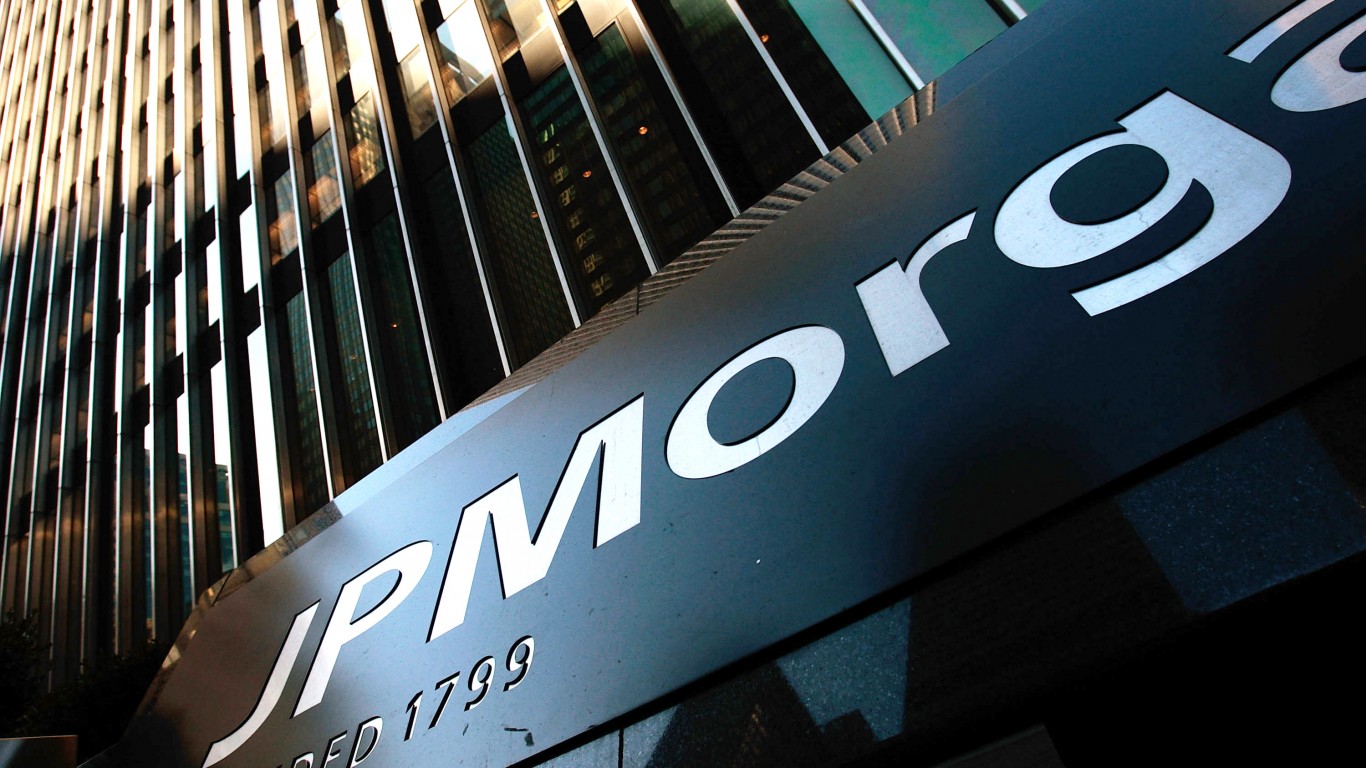

Before the opening bell on Wednesday, we are scheduled to get earnings results from three more big banks and one airline. Our earlier look at the bank stocks that are announcing earnings on Tuesday included a brief overview of what analysts are expecting the first big banks to report.
As for the airlines, travel has picked up sharply. On each of the past two weekends (included the holiday weekend), right around 2 million passengers passed through U.S. airports, according to the Transportation Security Administration checkpoint counts. That’s around three times more than were traveling on the same dates last year, but still not back to 2019 totals.
[in-text-ad]
Bank of America
Bank of America Corp. (NYSE: BAC) has seen its share price rise by nearly 72% in the past 12 months. For the year to date, the stock is up nearly 35%. At the end of the March quarter, its share price gain was around 65%, and the stock was up about 30% for the first three months of the year.
As with the other banks we’ve previewed, analysts are mostly bullish on the bank, with 17 of 26 rating the stock a Buy or Strong Buy and only two Sell/Strong Sell ratings. The median price target on the stock is $44.00, implying a potential upside of about 10% to a recent price of $40.35. At the high target of $52, the upside potential is about 30%.
The bank is expected to report second-quarter revenue of $21.8 billion, which would be down about 3% year over year and down about 4.3% sequentially. The earnings per share (EPS) estimate of $0.77 is more than double the year-ago quarter’s $0.37, but 13% lower than the first-quarter 2021 total of $0.86.
The stock currently trades at around 13.3 times expected 2021 EPS, 13.1 times estimated 2022 EPS and 11.8 times estimated 2023 earnings. The stock’s 52-week trading range is $22.95 to $43.49, and BofA pays an annual dividend of $0.84 (yield of 2.18%).
Citigroup
Citigroup Inc. (NYSE: C) is the country’s fifth-largest bank, with a market cap of more than $141 billion, less than half BofA’s value, and less than a third the size of leader JPMorgan. That’s below its fourth-place ranking at the end of the March quarter. Over the past year, the share price has improved by 35%, and the year-to-date gain is 13%. The pace of growth has slowed somewhat, however.
Analysts remain bullish, with 17 of 25 rating Citigroup shares a Buy or Strong Buy and the others rating the stock at Hold. The median 12-month price target on the stock is $85, and at a recent price of around $68.50, the implied upside is 24%. At the high target of $114, upside potential rises to 66%.
The bank is expected to report EPS of $1.98 (up from $0.50 in the same quarter last year), but down from $3.62 in the first quarter of 2021. Revenue is forecast to come in at $17.3 billion, down from $19.33 billion in the prior quarter and $19.77 billion in the year-ago quarter. For the full fiscal year, Citi is expected to report revenue of $70.63 billion, a dip of nearly 5% year over year, and EPS of $8.92, an increase of $83%.
The stock trades at around 7.9 times expected 2021 EPS, 8.5times estimated 2022 EPS and 7.6 times estimated 2023 earnings. The stock’s 52-week range is $40.49 to $80.29, and the bank pays an annual dividend of $2.04 (yield of 3.0%).
Delta Air Lines
Delta Air Lines Co. (NYSE: DAL) shares lost 31% in 2020, but over the past 12 months, the shares are up nearly 59%. The less-good news is that since the beginning of the year, shares are up just a bit more than 7%. Continued uncertainty about passenger air travel continues to rattle the industry.
Of 23 analyst ratings, 14 are Buy or Strong Buy. The rest of the analysts rate the stock at Hold. The median price target on Delta stock is $55, implying a potential upside of nearly 28% based on a recent price of around $43 per share. At the high target of about $73, the implied upside is nearly 70%.
Analysts expect Delta to post a second-quarter adjusted loss per share of $1.40 on revenue of $6.24 billion. In the second quarter of last year, Delta posted a loss per share of $4.43 on revenue of $1.47 billion. For the full year, analysts are forecasting revenue of $27.34 billion, up 60% year over year, and a loss per share of $3.67, compared with 2020’s loss of $10.76 per share.
The stock trades at a multiple of 10.8 times to estimated 2022 EPS and 6.5 times to estimated 2023 earnings. The stock’s 52-week range is $24.38 to $52.28. Delta has suspended its dividend.
Wells Fargo
Wells Fargo & Co. (NYSE: WFC) stock has risen by nearly 75% over the past 12 months, after closing out 2020 down nearly 42%. For the year to date, the shares are up 46%. The bank recently said that it will no longer offer new personal or portfolio lines of credit and it will shut down current accounts as it tries to streamline its business.
Analysts’ ratings on the stock are more mixed than on other big bank stocks. Eleven of 26 analysts have put a Hold rating on the stock, with 15 analysts rating the shares a Buy or Strong Buy. The median price target on the stock is $48.50, and shares recently traded at around $43.75, implying a potential upside of around 11% to the current price. At the high target of $60, the upside potential is about 37%.
Wells Fargo is expected to report second-quarter EPS of $0.95, down from $1.05 in the first quarter, but much better than the $0.66 per-share loss in the second quarter of 2020. Revenue for the quarter is forecast at $17.67 billion, down from $18.06 billion in the first quarter and down from $17.84 billion in the year-ago quarter. For the full fiscal year, analysts forecast EPS of $3.89, up nearly 850% from last year’s total of $0.41. Revenue is forecast at $70.71 billion, down about 2.3% year over year.
The stock currently trades at around 11.8 times expected 2021 EPS, 12.3 times estimated 2022 EPS and 10.3 times estimated 2023 earnings. The stock’s 52-week range is $20.76 to $48.13. Wells Fargo pays an annual dividend of $0.40 (yield of 0.89%).
Essential Tips for Investing: Sponsored
A financial advisor can help you understand the advantages and disadvantages of investment properties. Finding a qualified financial advisor doesn’t have to be hard. SmartAsset’s free tool matches you with up to three financial advisors who serve your area, and you can interview your advisor matches at no cost to decide which one is right for you. If you’re ready to find an advisor who can help you achieve your financial goals, get started now.
Investing in real estate can diversify your portfolio. But expanding your horizons may add additional costs. If you’re an investor looking to minimize expenses, consider checking out online brokerages. They often offer low investment fees, helping you maximize your profit.
Thank you for reading! Have some feedback for us?
Contact the 24/7 Wall St. editorial team.
 24/7 Wall St.
24/7 Wall St.


